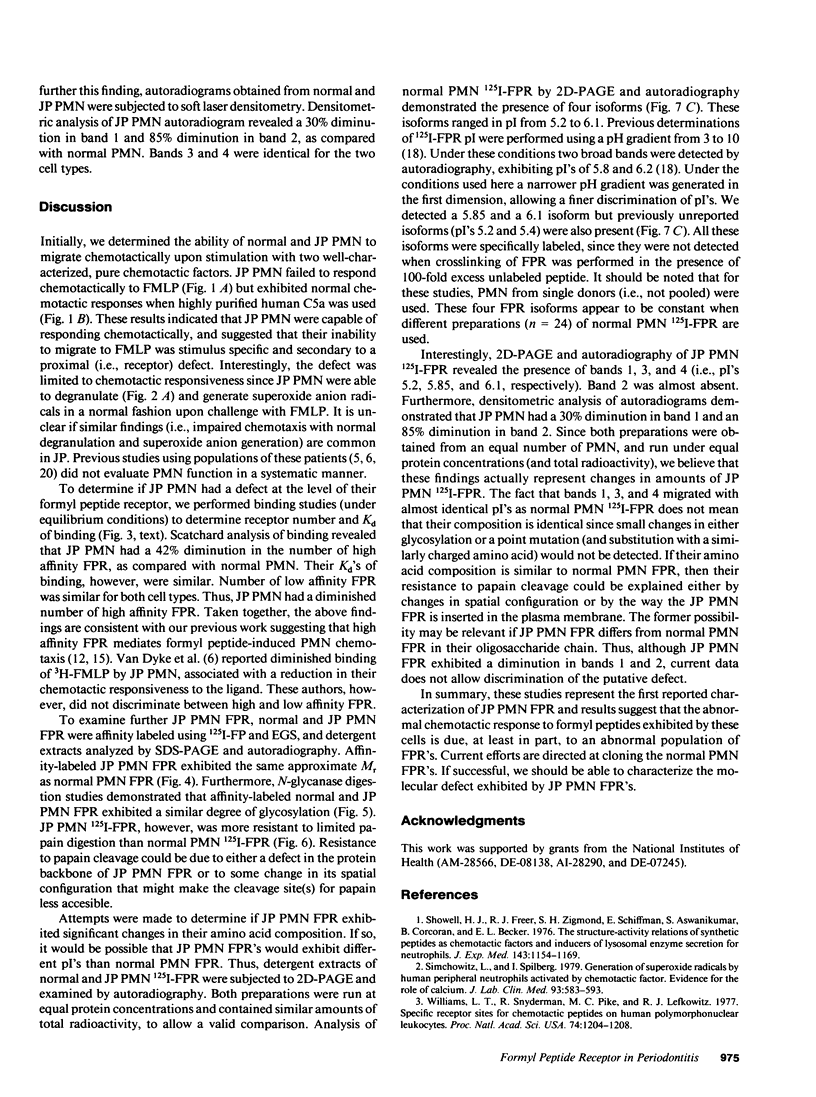Abstract
Juvenile periodontitis (JP) is a disease characterized by severe gingival infections. PMN from some JP patients exhibit abnormal chemotactic responsiveness when challenged with the synthetic formyl peptide, FMLP. While investigating PMN function in JP, we found a patient in whom abnormal PMN chemotactic responses to FMLP were associated with a defective population of PMN formyl peptide receptor(s) (FPR). JP PMN failed to respond chemotactically when challenged with FMLP, but exhibited normal chemotactic responses upon exposure to purified human C5a. Furthermore, JP PMN were capable of degranulating and generating superoxide anion radicals as well as normal PMN upon exposure to FMLP. Binding studies demonstrated that JP PMN had a diminution in the number of high-affinity FPR. Studies in which FPR was radiolabeled by chemical cross-linking demonstrated that JP PMN FPR exhibited the same molecular weight and N-linked glycosylation as normal PMN FPR. JP PMN FPR, however, was more resistant to papain cleavage than normal PMN FPR. Autoradiograms obtained from 2D-PAGE of normal and JP PMN FPR demonstrated decreased amounts of FPR isoforms in JP PMN.
Full text
PDF





Images in this article
Selected References
These references are in PubMed. This may not be the complete list of references from this article.
- Clark R. A., Page R. C., Wilde G. Defective neutrophil chemotaxis in juvenile periodontitis. Infect Immun. 1977 Dec;18(3):694–700. doi: 10.1128/iai.18.3.694-700.1977. [DOI] [PMC free article] [PubMed] [Google Scholar]
- Dolmatch B., Niedel J. Formyl peptide chemotactic receptor. Evidence for an active proteolytic fragment. J Biol Chem. 1983 Jun 25;258(12):7570–7577. [PubMed] [Google Scholar]
- Haffajee A. D., Socransky S. S., Ebersole J. L., Smith D. J. Clinical, microbiological and immunological features associated with the treatment of active periodontosis lesions. J Clin Periodontol. 1984 Oct;11(9):600–618. doi: 10.1111/j.1600-051x.1984.tb00913.x. [DOI] [PubMed] [Google Scholar]
- Koo C., Lefkowitz R. J., Snyderman R. The oligopeptide chemotactic factor receptor on human polymorphonuclear leukocyte membranes exists in two affinity states. Biochem Biophys Res Commun. 1982 May 31;106(2):442–449. doi: 10.1016/0006-291x(82)91130-5. [DOI] [PubMed] [Google Scholar]
- Malech H. L., Gardner J. P., Heiman D. F., Rosenzweig S. A. Asparagine-linked oligosaccharides on formyl peptide chemotactic receptors of human phagocytic cells. J Biol Chem. 1985 Feb 25;260(4):2509–2514. [PubMed] [Google Scholar]
- Niedel J., Wilkinson S., Cuatrecasas P. Receptor-mediated uptake and degradation of 125I-chemotactic peptide by human neutrophils. J Biol Chem. 1979 Nov 10;254(21):10700–10706. [PubMed] [Google Scholar]
- O'Farrell P. H. High resolution two-dimensional electrophoresis of proteins. J Biol Chem. 1975 May 25;250(10):4007–4021. [PMC free article] [PubMed] [Google Scholar]
- Page R. C., Schroeder H. E. Pathogenesis of inflammatory periodontal disease. A summary of current work. Lab Invest. 1976 Mar;34(3):235–249. [PubMed] [Google Scholar]
- Perez H. D., Elfman F., Chenoweth D., Hooper C. Preparation and characterization of a derivative of wheat germ agglutinin which specifically inhibits polymorphonuclear leukocyte chemotaxis to the synthetic chemotactic peptide N-formyl-methionyl-leucyl-phenylalanine. J Immunol. 1986 Mar 1;136(5):1813–1819. [PubMed] [Google Scholar]
- Perez H. D., Elfman F., Lobo E. Removal of human polymorphonuclear leukocyte surface sialic acid inhibits reexpression (or recycling) of formyl peptide receptors. A possible explanation for its effect on formyl peptide-induced polymorphonuclear leukocyte chemotaxis. J Immunol. 1987 Sep 15;139(6):1978–1984. [PubMed] [Google Scholar]
- Perez H. D., Elfman F., Marder S., Lobo E., Ives H. E. Formyl peptide-induced chemotaxis of human polymorphonuclear leukocytes does not require either marked changes in cytosolic calcium or specific granule discharge. Role of formyl peptide receptor reexpression (or recycling). J Clin Invest. 1989 Jun;83(6):1963–1970. doi: 10.1172/JCI114105. [DOI] [PMC free article] [PubMed] [Google Scholar]
- Perez H. D., Kelly E., Chenoweth D., Elfman F. Identification of the C5a des Arg cochemotaxin. Homology with vitamin D-binding protein (group-specific component globulin). J Clin Invest. 1988 Jul;82(1):360–363. doi: 10.1172/JCI113595. [DOI] [PMC free article] [PubMed] [Google Scholar]
- Perez H. D., Lipton M., Goldstein I. M. A specific inhibitor of complement (C5)-derived chemotactic activity in serum from patients with systemic lupus erythematosus. J Clin Invest. 1978 Jul;62(1):29–38. doi: 10.1172/JCI109110. [DOI] [PMC free article] [PubMed] [Google Scholar]
- Showell H. J., Freer R. J., Zigmond S. H., Schiffmann E., Aswanikumar S., Corcoran B., Becker E. L. The structure-activity relations of synthetic peptides as chemotactic factors and inducers of lysosomal secretion for neutrophils. J Exp Med. 1976 May 1;143(5):1154–1169. doi: 10.1084/jem.143.5.1154. [DOI] [PMC free article] [PubMed] [Google Scholar]
- Simchowitz L., Spilberg I. Generation of superoxide radicals by human peripheral neutrophils activated by chemotactic factor. Evidence for the role of calcium. J Lab Clin Med. 1979 Apr;93(4):583–593. [PubMed] [Google Scholar]
- Van Dyke T. E., Horoszewicz H. U., Cianciola L. J., Genco R. J. Neutrophil chemotaxis dysfunction in human periodontitis. Infect Immun. 1980 Jan;27(1):124–132. doi: 10.1128/iai.27.1.124-132.1980. [DOI] [PMC free article] [PubMed] [Google Scholar]
- Van Dyke T. E., Levine M. J., Tabak L. A., Genco R. J. Reduced chemotactic peptide binding in juvenile periodontitis: a model for neutrophil function. Biochem Biophys Res Commun. 1981 Jun 16;100(3):1278–1284. doi: 10.1016/0006-291x(81)91962-8. [DOI] [PubMed] [Google Scholar]
- Williams L. T., Snyderman R., Pike M. C., Lefkowitz R. J. Specific receptor sites for chemotactic peptides on human polymorphonuclear leukocytes. Proc Natl Acad Sci U S A. 1977 Mar;74(3):1204–1208. doi: 10.1073/pnas.74.3.1204. [DOI] [PMC free article] [PubMed] [Google Scholar]
- Zigmond S. H. Consequences of chemotactic peptide receptor modulation for leukocyte orientation. J Cell Biol. 1981 Mar;88(3):644–647. doi: 10.1083/jcb.88.3.644. [DOI] [PMC free article] [PubMed] [Google Scholar]
- Zigmond S. H., Hirsch J. G. Leukocyte locomotion and chemotaxis. New methods for evaluation, and demonstration of a cell-derived chemotactic factor. J Exp Med. 1973 Feb 1;137(2):387–410. doi: 10.1084/jem.137.2.387. [DOI] [PMC free article] [PubMed] [Google Scholar]






